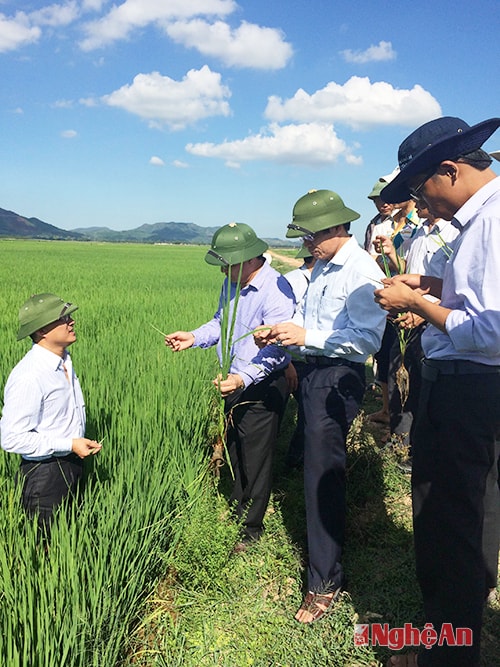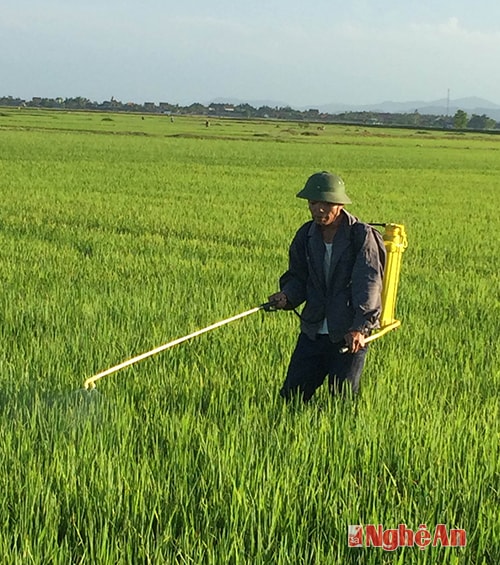Leaf roller epidemic control: Many localities are slow to implement
(Baonghean) - The long stretches of rice fields are covered in the silver color of burnt rice leaves caused by leaf rollers. Local people said that it has been the first time in recent years that such a severe outbreak of leaf rollers has occurred. To date, the entire province has had 70,232 hectares of rice affected by leaf roller disease. On July 18, the Provincial People's Committee had to issue a decision to declare the epidemic. However, in many localities, there is still a subjective situation in prevention and control work.
Ms. Cao Thi Dao's family (Hamlet 5, Hung Thong Commune - Hung Nguyen) has 10 sao of rice fields. Following the commune's recommendations, she bought special medicine to spray on July 19. "Almost the entire field is infected. It's been a long time since we've seen such a severe outbreak of leaf rollers. Currently, the rice is growing well, but if the worms continue to develop, we have to spray again," said Ms. Dao. Mr. Cao Van Tu (agricultural officer of Hung Thong Commune) said that the third generation of worms appeared on June 10, over 100 hectares were infected with a relatively high density. The commune has announced and advised people to take drastic measures to prevent them, but nearly a month later, on July 8 and 9, the fourth generation of worms appeared in large numbers in the fields. Out of the 290 hectares of rice in the commune, over 200 hectares were infected with worms, with a density of up to 200 worms/m2 in some places. According to Mr. Tu, although the district and commune had timely recommendations, because the worms were at the 1st and 2nd instars (the best and most effective prevention period), the rice leaves were still green and lush, so people hesitated and were subjective, leading to late spraying, reducing the effectiveness of the spraying, and some families even waited until July 22 to spray.
 |
| Leaders of the Agriculture sector inspect leaf roller control in Nam Thanh commune (Nam Dan). |
Along with Yen Thanh, Dien Chau, Thanh Chuong..., Hung Nguyen is considered one of the localities with quite drastic measures in preventing leaf rollers. The whole district has nearly 5,400 hectares of summer-autumn rice. As early as July 7, the district Plant Protection Station announced that the fourth generation of larvae would appear from July 13 and advised on prevention measures. Immediately after that, measures were urgently deployed, establishing a Steering Committee and groups with technical staff as the core, urging to focus on prevention from July 15 to 20, the district allocated the budget to support 30% of the cost of medicine. In addition, 8 communes such as Hung Tan, Hung My, Hung Xuan, town... supported an additional 20 - 40% of the cost of medicine. On July 20, about 80% of the summer-autumn rice area in the whole district had been sprayed with different types of medicine, equal to 4,228 hectares/5,395 hectares.
However, according to Mr. Le Viet Hung (Head of the District Plant Protection Station), due to favorable weather conditions for pests to arise, develop and cause damage, and at the same time, pests have overlapping generations, so the density in some areas continues to increase. In addition, in some areas such as Hung Tay, Hung Yen... farmers are still subjective, do not prevent or prevent with the right specific drugs, spray pesticides not according to the "4 correct" principle, do not mix enough water, even though they have been supported with money for pesticides, they still buy cheaper drugs to spray, so currently in some areas the density of pests is still quite high. Especially in late-planted tea, the tillering stage is strong, there are areas where pesticides are not sprayed, the density is up to 500 - 800 insects/m2. Currently, the whole district still has 2,200 hectares of rice infected with pests, of which 666 hectares are heavily infected, many areas have not been prevented.
 |
| People of Hung Thong (Hung Nguyen) spray insecticide for leaf rolling. |
Nam Dan district has 5,990 hectares of summer-autumn rice, of which 4,942 hectares are infected with leaf rollers, of which 3,481 hectares are heavily infected, nearly 1,000 hectares are moderately infected. Walking along the communes of Van Dien, Kim Lien... it is not difficult to see patches of dry, withered silver leaves. According to general assessment, this is one of the localities that has been quite slow in implementing preventive spraying. On July 14, the district organized a campaign for the entire population to fight against leaf rollers, at this time the 4th generation of worms had appeared in the communes, but many communes still implemented very slowly. Apart from some communes such as Nam Thanh, Khanh Son, Nam Cat... that were interested in doing it early, the effectiveness of preventive spraying was higher, most of them sprayed quite late even though the weather was favorable for preventive spraying. Most farmers sprayed pesticides from July 17 to 21, resulting in low efficiency. In some places, such as in Sen 1 hamlet (Kim Lien), although the commune provided pesticides, farmers were only able to spray 80% of the area. The spraying was done late, so many rice fields were burned. "Slow and subjective" - that is the general opinion of the technical staff assigned to direct in Nam Dan.
Mr. Tran Dinh Loc (officer of the district Plant Protection Station) said: Kim Lien has 640/662 hectares of summer-autumn rice infected with leaf roller disease. From July 14, the first instar 4 larvae began to appear, but on July 15, when the commune officials were sent to the field to directly check, the density of worms had reached 300 - 400 individuals/m2, in some places 800 - 1,000 individuals/m2, the commune believed and organized the implementation of spraying. However, the implementation was still slow and not given due attention. At the same time, people were subjective, only a very small number of areas were sprayed from July 14 - 16 and these areas are currently growing well. On July 18, the Plant Protection Station staff continued to work with the commune, but on July 19, after making a record of inspection and work, the commune began to vigorously deploy, supplying pumps and chemicals for spraying from the afternoon of July 20. However, at this time, many rice areas were burned but only 1/3 of the amount of chemicals was sprayed. "Currently, the rice is in the tillering stage, there is still the ability to recover, but if in the upcoming 5th stage, right at the stage of rice forming panicles, the spraying is still carried out in this way, the yield will be severely affected" - Mr. Loc worried.
According to the synthesis of the Provincial Plant Protection Department, as of July 21, the whole province had over 70,232 hectares of rice infected with pests, of which nearly 42,503 hectares were heavily infected. The common worm density was 80 - 100 individuals/m2, in high places 200 - 300 individuals/m2, and in some cases 500 - 700 individuals/m2. Currently, the worms are mainly at age 3 and 4. Up to now, basically 100% of localities with areas infected with pests have actively participated in directing farmers to prevent the epidemic. The total area sprayed by July 22 was nearly 54 thousand hectares, reaching 76.5% of the area that needed to be prevented. However, according to the general assessment, in addition to the areas that were sprayed at the right time and in accordance with the instructions of specialized agencies with basically good results, in some localities, the management of pesticide use is still not good; People's awareness of using pesticides is not high, so many farmers still use non-specific pesticides according to instructions or use pesticides not according to technical requirements. In addition, some areas have rained after spraying or the density of pests is too high, so although they have been sprayed, the density of pests is still high, above the control threshold, so there is still the possibility of serious damage. Even many areas with high density of pests that have not been sprayed have started to burn white.
According to Mr. Nguyen Tien Duc (Head of the Provincial Plant Protection Department), in the coming time, the weather and growth stage of rice plants will be very favorable for the small leaf roller to develop and cause damage. On the other hand, the worm will move to the 4th and 5th instar stage, which is the stage where it can cause great and rapid damage, seriously affecting the growth and development and rice yield if timely and effective spraying is not organized. Meanwhile, up to now, there are still about 16 thousand hectares of rice infected with worms that have not been sprayed. Some areas have been sprayed, but because the worms are causing damage at too high a density and the spraying is still inadequate, the worms are still causing serious damage. Therefore, in the next few days, localities and farmers need to continue spraying according to the instructions to avoid the worms causing severe damage that completely whitens the leaves.
Article and photos:Phu Huong






